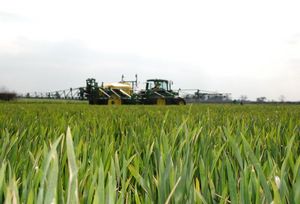We live in the Trumpington ward of Cambridge. Since the US election there has been a debate amongst some residents about the Trump in Trumpington. A local LibDem councillor has been very concerned and has changed his Twitter handle because it contained the dreaded word Trump.
Trumpington is expanding at an enormous rate and the land where the famous Plant Breeding Institute (PBI) once stood is now being gradually covered with houses. I looked at the name of some of the new streets. They invoke memories of varieties past; Proctor, Rialto, Bead, Consort, Piper, Avalon, Charger, Kestrel, Osprey and Hereward. Many of these had the handle Maris. This was because the PBI entrance was on Maris Lane. Incidentally, I came across Mrs Maris’ grave recently when helping to give the churchyard a bit of a spruce up.
The other variety that appears as a street name is Huntsman. Its introduction helped to start the surge towards greater wheat yields in the 1970s. I started in the National Agricultural Advisory Service (the predecessor of ADAS) in 1969 and one of my first jobs was to sow a winter wheat trial in South Essex. It was the first year that Maris Huntsman was in the NIAB Recommended List trials and my scores showed that it was visually very disappointing over the winter. However, the harvest demonstrated its true value.
There were many other significant introductions to the industry during the 1970s; for instance, chlorotoluron and isoproturon came on the market in 1971. In the early years, chlorotoluron was the more effective black-grass killer but it was more vulnerable to herbicide resistance and isoproturon came to the fore in the 1980s.
 It is easy to overlook what these herbicides achieved. My personal experience was that the longer-term arable soils had terrible structure in the late 1960s and 1970s as a result of intensive late-autumn and spring-cropping. At the same time the Government commissioned the Strutt report ‘Modern Farming and the Soil ‘. This was published in 1970/71 and described the parlous state of our longer-term arable soils. Effective grass weed control not only resulted in a huge increase in autumn sowing, with its attendant advantages of plant cover and an effective root system during the winter, but also their sowing dates were brought forward to a time when typically soils were drier and less susceptible to damage. This all resulted in a huge improvement in soil structure and helped to set the scene for a near doubling of winter wheat yields between 1976 and 1984.
It is easy to overlook what these herbicides achieved. My personal experience was that the longer-term arable soils had terrible structure in the late 1960s and 1970s as a result of intensive late-autumn and spring-cropping. At the same time the Government commissioned the Strutt report ‘Modern Farming and the Soil ‘. This was published in 1970/71 and described the parlous state of our longer-term arable soils. Effective grass weed control not only resulted in a huge increase in autumn sowing, with its attendant advantages of plant cover and an effective root system during the winter, but also their sowing dates were brought forward to a time when typically soils were drier and less susceptible to damage. This all resulted in a huge improvement in soil structure and helped to set the scene for a near doubling of winter wheat yields between 1976 and 1984.
Bringing forward autumn sowing dates also meant a larger crop going into the winter with the advantages that it entails: more plant cover over-winter and a larger root system. Now that we are seeing a retreat from autumn cropping and a return to later autumn sowing dates, we have to remember these lessons from recent history. There is evidence that these lessons have been learnt because of the current enthusiasm for cover crops prior to spring crops.
I have been debating with colleagues as to whether a cover crop followed by a spring cereal is as beneficial as an early-sown winter crop. Typically the objective of a cover crop is to produce more green material in the autumn than is achieved with a winter cereal crop sown at optimum seed rates for grain yield. In addition, it has been suggested (but not, as far as I know, proven) that it may be advantageous for the soil biomass of fungi and bacteria that the cover crop is an entirely different type of plant from the following spring crop and also from other crops that appear in the rotation.
A major issue on the heavy clays is that cover crop management is not easy, particularly the transition between the cover crop and the sowing of the spring crop because there can be a delay in the soil surface layers drying out in spring. I am sure that the inventiveness of the industry will come up with some practical solutions. My experience in the early 1970s suggests that these solutions will be very beneficial in helping to retain the structure of heavy soils where black-grass control necessitates spring cropping. However, it would more straight-forward and profitable to be able to chemically control black-grass in early autumn-sown crops!
